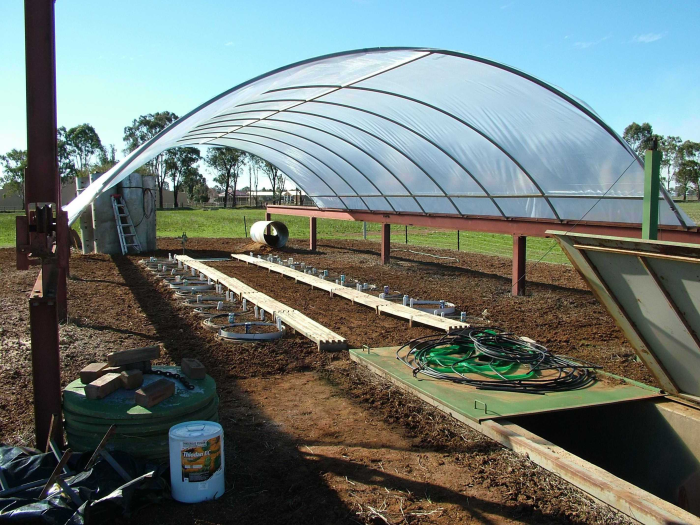




チャールズ・スタート大学 (CSU) のリゾリシメーターは、南半球最大の根の成長研究施設の 1 つで、EH グラハム農業イノベーション センターと提携しています。この施設には、6 mm の鋼管に収められた 24 個の無傷の土壌モノリス (高さ 2.5 m、直径 0.76 m) があります。収容された土壌モノリスは、地下のリゾリシメーター ラボに 12 列に並べられており、土壌表面から 0.6 ~ 2.5 m 下の土壌コアの側面にアクセスできます。施設の設計により、総合的な根の成長と土壌水分のダイナミクスを非破壊でその場で高時間分解能で測定できます。土壌モノリスには、さまざまなセンサーを取り付けることができます。リゾリシメーター コンプレックスの建設は 1995 年に開始され、ARC メカニズム B インフラストラクチャ助成金 16 万ドルによって資金提供されました。施設の機器を完成させるために、CSU 研究インフラストラクチャ ブロック助成金制度からさらに 30,000 ドルの助成金を獲得しました。施設は 1998 年に稼働を開始しました。
センサー
現在、各土壌モノリスには、6 本のミニリゾトロン透明チューブと 7 本の TDR (時間領域反射測定法) センサーが取り付けられています。ミニリゾトロン チューブは直径 3 cm で、20、40、65、90、145、205 cm の深さに水平に設置されています。ミニリゾトロン チューブは合計 144 本あります。アナログおよびデジタル画像機器により、根の画像をキャプチャして、その場で根の動態を定量化できます。TDR は、Tektronix 1502C ケーブル テスター (Campbell Scientific の価格表では TDR100 に置き換えられています) に接続された 3 ロッドの 30 cm センサーです。TDR は、15、30、55、75、105、135、190 cm の深さに挿入されています。このシステムは、Campbell Scientific CR10X データロガーと 24 個の SDMX50 マルチプレクサによって制御されます。合計 168 個の TDR センサーがあります。TDR は、土壌水分量を 48 分ごとに測定するようにプログラムされています。
現在の研究
現在のプロジェクト(GRDC プロジェクト UCS00003)は、「地下水涵養を制御し、乾燥した集水域を維持するためにバイオポアを最大限に活用する輪作の順序付け」と題されており、その目的は、(1)土壌の深さに関連して、アルファルファの根が土壌内でどのように腐敗するか、および残存するバイオポアの安定性を判断すること、(2)アルファルファの牧草地段階に続く段階的農業輪作の次の作物段階で、対照的な土壌がどのように湿潤するかを判断すること、および(3)残存するアルファルファのバイオポアを活用し、表土および下層土の水を捕捉する能力における作物種間の差異を判断することである。
これまでの研究
先行プロジェクト (GRDC プロジェクト UCS29) の「アルファルファの水分吸収強化による再充填制御による持続可能な輪作」では、アルファルファの根と水の動態が研究されました。UCS29 の重要な発見には、夏季にアルファルファの樹冠は表面散水 (降雨) には反応しましたが、深層土壌散水 (地下水位の利用可能性) には反応しなかったことが含まれています。この発見は、アルファルファが塩分濃度と戦う上で果たす役割に重要な意味を持っています。このプロジェクトのさらなる発見は、参照出版物に記載されています。
注: 許可を得て転載
- JD Hoffmann、PL Eberbach、JA Virgona、A. Katupitiya。2001 夏の水やりによるアルファルファの根の成長。オーストラリア農学会議議事録、オーストラリア農学協会。www.regional.org.au/au/asa/2001/p/16/ hoffmann.htm
- JD Hoffmann、PL Eberbach、JA Virgona、A. Katupitiya。2003 アルファルファによる節水水利用。オーストラリア農学会議議事録、オーストラリア農学協会。www.regional.org.au/au/asa/2003/c/10/ hoffmann.htm
- JS Moroni、PL Eberbach、JA Virgona。2006 アルファルファ (Medicago sativa L.) の栽培履歴がその後のキャノーラ (Brassica napus L.) と小麦 (Triticum aestivum L.) 作物の根の動態に与える影響。オーストラリア農学会議議事録、オーストラリア農学協会。www.regional.org.au / au/asa/2006
オーストラリア研究会議、チャールズ・スタート大学、穀物研究開発公社から資金提供を受けています。